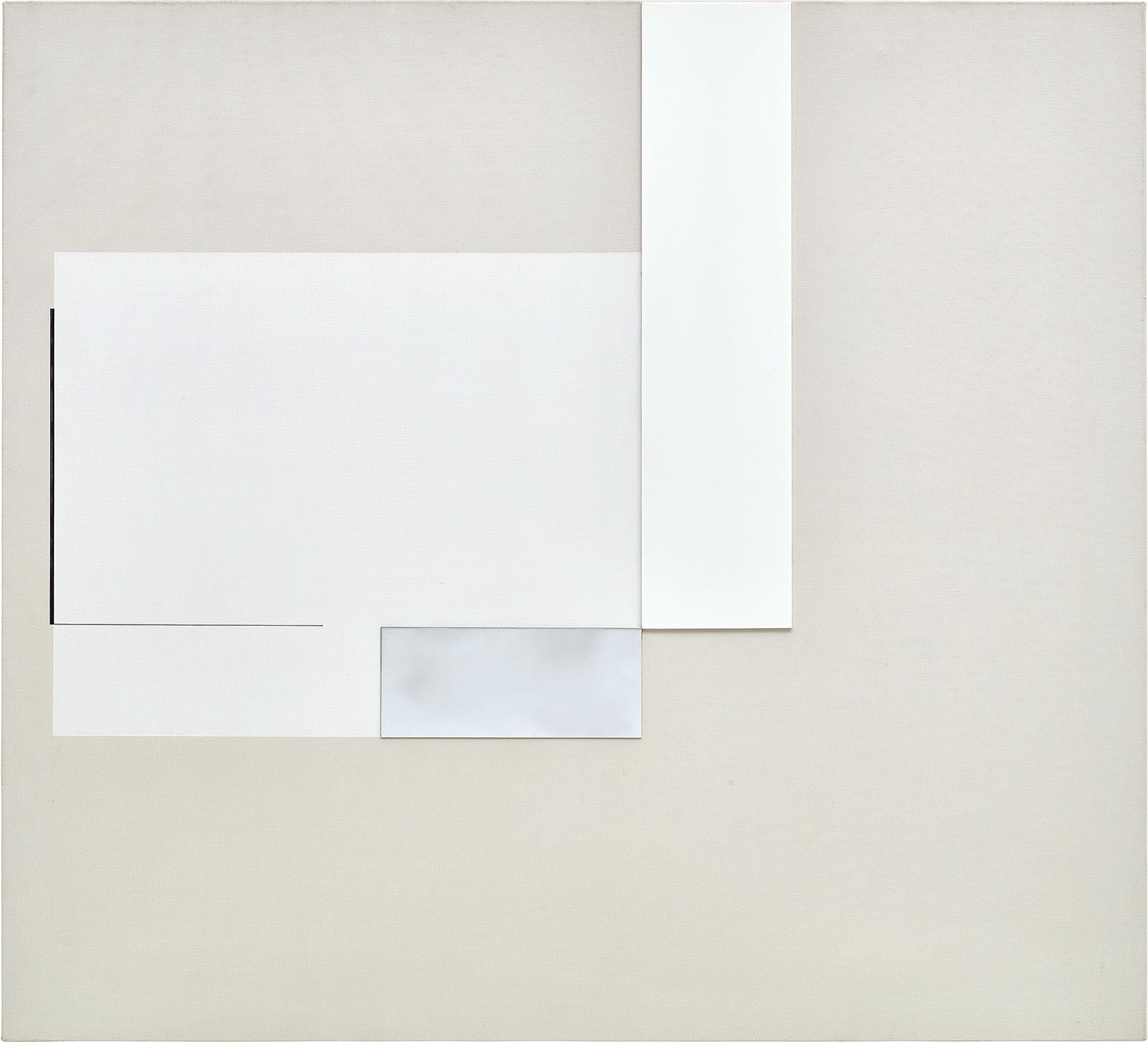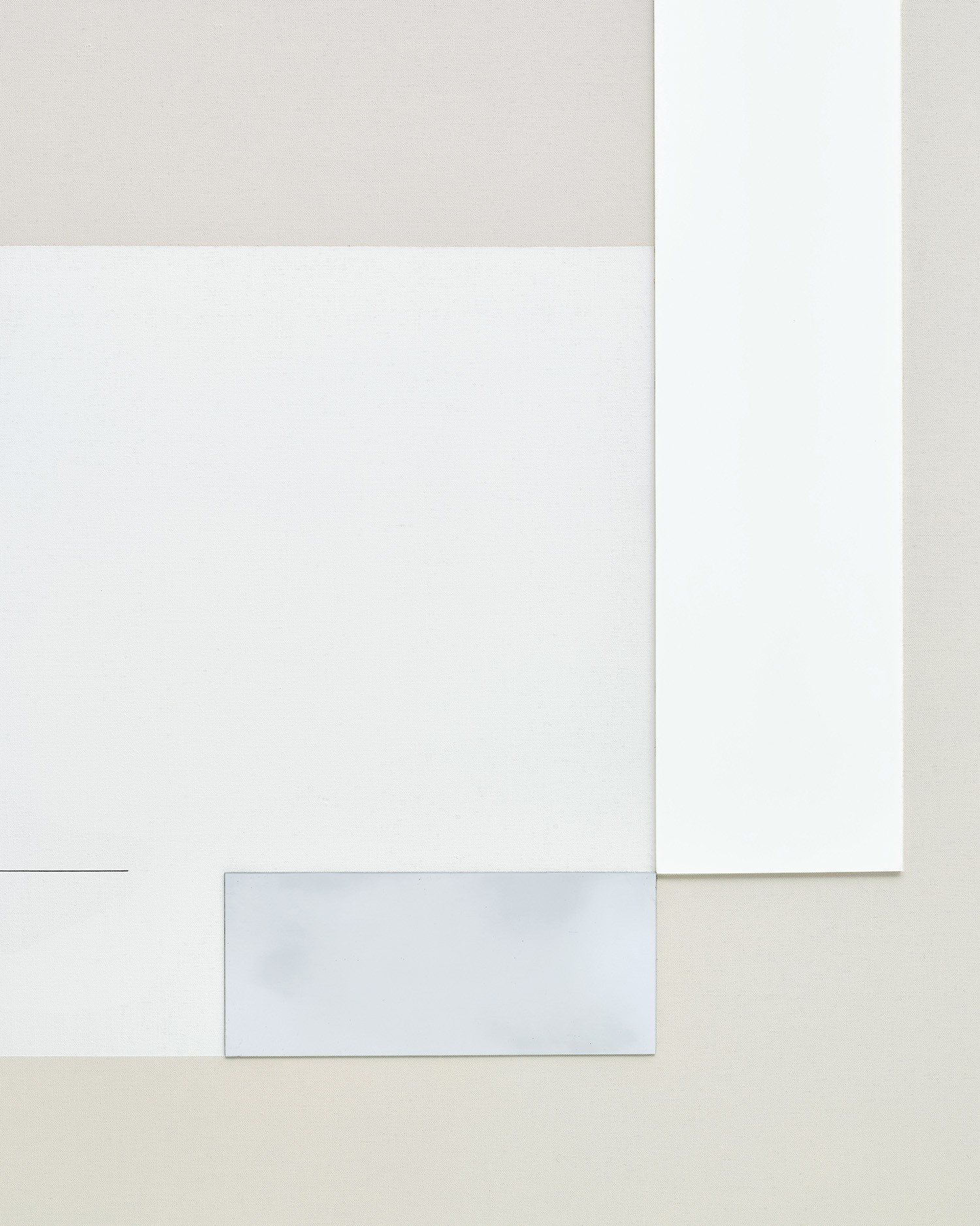



Property of a Private British Collector
12
Richard Lin
Painting Relief
signed, titled and dated 'LIN SHOU YU "PAINTING RELIEF" 1‧MAY‧1963' on the reverse
oil, perspex and aluminium on canvas
101.6 x 111.8 cm. (40 x 44 in.)
Executed on 1 May 1963.
Full-Cataloguing
“White is the most ordinary of colours, it is also the most extraordinary; it is the absence of colour, it is also the sum of colours; it is the most majestic of colours, it is also the most common; it is the colour of tranquility, it is also the colour of grief.” Richard Lin
Fusing the elegant geometry of western Minimalist sculpture with the sparse purity of Chinese literati painting, Richard Lin’s master work Painting Relief is a profound meeting of two of history’s most powerful aesthetic traditions. Created at the early apex of the artist’s career in 1963, this large scale piece is an outstanding constituent of the artist’s iconic White Series. Composed of delicately coloured oblongs of aluminium and perspex, Lin balances fields of monotone abstraction which seem to float independently of one another, delineated by acute variations in tone that also spark a dialogue with the concurrently developing movement of Op Art. Wall mounted, yet having a unique presence as relief, Lin crucially interrogates the boundaries between painting and sculpture to create a new space for art that transcends stylistic classification. Born out of his rare position as an artist who travelled between art centres of Asia and Europe in the mid-20th century, in Painting Relief we witness Lin’s profound contribution to a global art history in its nascent stages of becoming; bringing together the western essentialism of minimalist aesthetics with the holistic relations between the micro and macro as expressed in Eastern Philosophical tendencies.
Born in 1933 to a prominent family in central Taiwan, from an early age Lin was immersed in multiple East Asian cultural aesthetics. As a child he was educated in the art of Chinese Calligraphy and between the ages of 6 and 12 he was placed under the tutelage of a family in Japan. Finally in 1949, at the age of 16, Lin began his independent education in Hong Kong. Following this deep familiarisation with the history of Eastern cultures, Lin made an important and defining move to England in 1952, going on to study Architecture at Regent Street Polytechnic (now the University of Westminster) two years later. Whilst focusing on architectural studies in the day, Lin devoted his evenings to studying painting, taking influence from the developing styles of European modernism. This dual line of artistic enquiry is wonderfully demonstrated in the definitive structural integrity of the present work. Whilst Lin was drawn to the legacies of artistic movements such as Cubism and Constructivism, he simultaneously was inspired by the revolutionary architecture stemming from the Bauhaus, as well as movements which combined the two disciplines such as De Stijl. Privileging strong orthogonals as a means of constructing plastic space and structure, undoubtedly the work of De Stijl pioneer Piet Mondrian can be traced in the present work.
As well as citing British artists such as Ben Nicholson, whose work he viewed at the Tate gallery upon his arrival in London in 1952, and where works also form part of the collection from which the present work comes, Lin’s first experimental paintings in the 1950s also drew from American Abstract Expressionists, drawing parallels with select artists of the Black Mountain college who drew from Eastern philosophies in their own work. In 1958 he began layering blocks of black and white on canvas to explore the elemental contrasts fundamental to painting. It was in the 1960s, however, that Lin took further steps of reduction: paring down his compositions and tonal choices to focus on the pure power of white, he gave birth to the iconic White Series, of which Painting Relief is a preeminent and outstanding example. Lin’s attentiveness to physical process and his conceptualisation of painting a pure object posited him a contributor to the most important artistic impulses that defined western art at this time. Indeed, when he started the White Series the term ‘minimalism’ had not yet been coined. Receiving widespread recognition in Europe, he participated in some of the most pioneering exhibitions of this important decade such as Documenta III in Kassel in 1964, which marked a turning point for minimal art in Europe, and the Carnegie International in Pittsburg in 1967 where he was awarded the William Frew Memorial Purchase Award alongside Francis Bacon.
Akin to the revolutionary white paintings of Robert Ryman, or the grid paintings of Agnes Martin, the subtle variations of tone between the whites that dominate Painting Relief train and attune our eyes to appreciate acute nuances within the pared down palette. However, in contrast to these artists, Lin insists on the economic use of dark and blackened blocks, anchoring the work at the peripheries and providing it with a more lyrical sense of balance. It is here that Lin expresses the influence of Eastern philosophy, in which form and emptiness work in polarised symbiosis to generate one another, like yin and yang. At a later solo exhibition in Belgium in 1970, Lin would clarify that his paintings evoke the fluidity and vigour so valued in the art of calligraphy, and that they embody the tenants of Taoism as expounded by the book of change; namely, that all existence springs from nothingness. Whilst audiences have often been quick to categorise Lin’s works as minimalist, Lin explained that they are also deeply analogous to the work of Northern Song Dynasty artist, Mi Fu (1051-1107). As evidenced in Painting Relief, Lin does not adhere to the dogma of Minimalism in its fullest, rather he is able to imbue this aesthetic with a peculiar energy and fluid sensibility that elevates the emotive capacities of the rational composition. Thus, bringing together the common tendencies of two historically separated artistic schools, Lin announces himself as a true pioneer who is sensitive and contributive to the aesthetic zeitgeist across geographic boundaries.
Fusing the elegant geometry of western Minimalist sculpture with the sparse purity of Chinese literati painting, Richard Lin’s master work Painting Relief is a profound meeting of two of history’s most powerful aesthetic traditions. Created at the early apex of the artist’s career in 1963, this large scale piece is an outstanding constituent of the artist’s iconic White Series. Composed of delicately coloured oblongs of aluminium and perspex, Lin balances fields of monotone abstraction which seem to float independently of one another, delineated by acute variations in tone that also spark a dialogue with the concurrently developing movement of Op Art. Wall mounted, yet having a unique presence as relief, Lin crucially interrogates the boundaries between painting and sculpture to create a new space for art that transcends stylistic classification. Born out of his rare position as an artist who travelled between art centres of Asia and Europe in the mid-20th century, in Painting Relief we witness Lin’s profound contribution to a global art history in its nascent stages of becoming; bringing together the western essentialism of minimalist aesthetics with the holistic relations between the micro and macro as expressed in Eastern Philosophical tendencies.
Born in 1933 to a prominent family in central Taiwan, from an early age Lin was immersed in multiple East Asian cultural aesthetics. As a child he was educated in the art of Chinese Calligraphy and between the ages of 6 and 12 he was placed under the tutelage of a family in Japan. Finally in 1949, at the age of 16, Lin began his independent education in Hong Kong. Following this deep familiarisation with the history of Eastern cultures, Lin made an important and defining move to England in 1952, going on to study Architecture at Regent Street Polytechnic (now the University of Westminster) two years later. Whilst focusing on architectural studies in the day, Lin devoted his evenings to studying painting, taking influence from the developing styles of European modernism. This dual line of artistic enquiry is wonderfully demonstrated in the definitive structural integrity of the present work. Whilst Lin was drawn to the legacies of artistic movements such as Cubism and Constructivism, he simultaneously was inspired by the revolutionary architecture stemming from the Bauhaus, as well as movements which combined the two disciplines such as De Stijl. Privileging strong orthogonals as a means of constructing plastic space and structure, undoubtedly the work of De Stijl pioneer Piet Mondrian can be traced in the present work.
As well as citing British artists such as Ben Nicholson, whose work he viewed at the Tate gallery upon his arrival in London in 1952, and where works also form part of the collection from which the present work comes, Lin’s first experimental paintings in the 1950s also drew from American Abstract Expressionists, drawing parallels with select artists of the Black Mountain college who drew from Eastern philosophies in their own work. In 1958 he began layering blocks of black and white on canvas to explore the elemental contrasts fundamental to painting. It was in the 1960s, however, that Lin took further steps of reduction: paring down his compositions and tonal choices to focus on the pure power of white, he gave birth to the iconic White Series, of which Painting Relief is a preeminent and outstanding example. Lin’s attentiveness to physical process and his conceptualisation of painting a pure object posited him a contributor to the most important artistic impulses that defined western art at this time. Indeed, when he started the White Series the term ‘minimalism’ had not yet been coined. Receiving widespread recognition in Europe, he participated in some of the most pioneering exhibitions of this important decade such as Documenta III in Kassel in 1964, which marked a turning point for minimal art in Europe, and the Carnegie International in Pittsburg in 1967 where he was awarded the William Frew Memorial Purchase Award alongside Francis Bacon.
Akin to the revolutionary white paintings of Robert Ryman, or the grid paintings of Agnes Martin, the subtle variations of tone between the whites that dominate Painting Relief train and attune our eyes to appreciate acute nuances within the pared down palette. However, in contrast to these artists, Lin insists on the economic use of dark and blackened blocks, anchoring the work at the peripheries and providing it with a more lyrical sense of balance. It is here that Lin expresses the influence of Eastern philosophy, in which form and emptiness work in polarised symbiosis to generate one another, like yin and yang. At a later solo exhibition in Belgium in 1970, Lin would clarify that his paintings evoke the fluidity and vigour so valued in the art of calligraphy, and that they embody the tenants of Taoism as expounded by the book of change; namely, that all existence springs from nothingness. Whilst audiences have often been quick to categorise Lin’s works as minimalist, Lin explained that they are also deeply analogous to the work of Northern Song Dynasty artist, Mi Fu (1051-1107). As evidenced in Painting Relief, Lin does not adhere to the dogma of Minimalism in its fullest, rather he is able to imbue this aesthetic with a peculiar energy and fluid sensibility that elevates the emotive capacities of the rational composition. Thus, bringing together the common tendencies of two historically separated artistic schools, Lin announces himself as a true pioneer who is sensitive and contributive to the aesthetic zeitgeist across geographic boundaries.